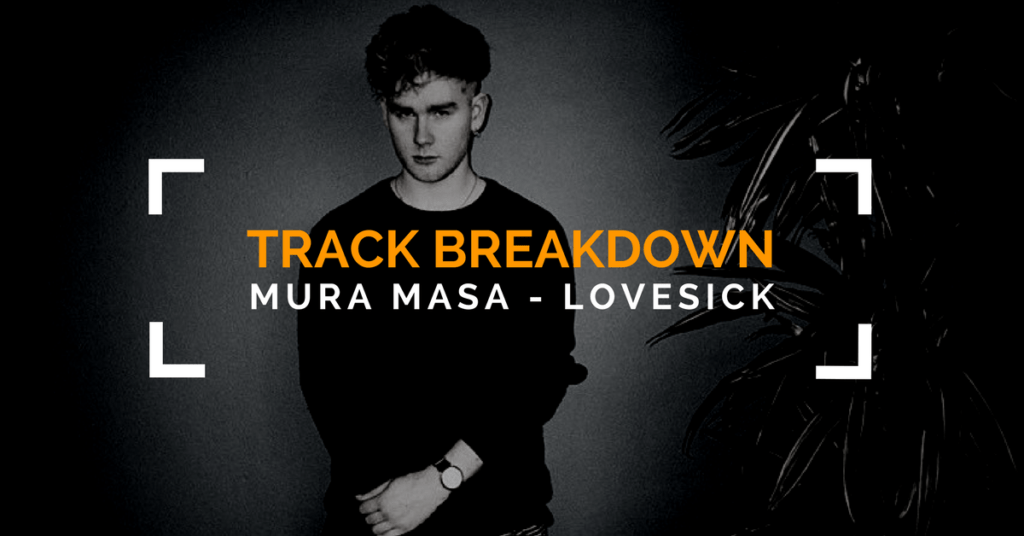Welcome to the first installment of our article series, Track Breakdowns.
In this series, we break down the music theory and arrangement behind popular songs, ultimately showing you what makes each song work.
In this track breakdown, we’ll analyze Mura Masa’s “Lovesick”.
First, we’ll transcribe the main melodic content in the track.
Then, we’ll look at the midi and listen to the main instruments.
Finally, we’ll dig deeper into the track, analyzing the structure, melodic content, and arrangement.
We chose this track to kick off the series, because, from a melodic standpoint, the track is relatively simple:
- The chord progression is 2 bars long using 3 chords, and repeats throughout most of the song.
- The main melodic motif repeats in both the verse and the chorus.
- The simplicity of the melodic content and development allows for the track to seamlessly flow between sections.
And even with this simplicity, the main motif is strong enough to carry through the full length of the track.
Want free access to the Track Breakdown MIDI Vault? You can download the MIDI from all of our Track Breakdowns, as well as 25 hi-quality MIDI chord progressions you can use in your own productions.
Get 25 high-quality MIDI chord progression files for free 🎹
Our Track Breakdown MIDI Vault is packed with chord progression MIDI files from songs like Mura Masa’s ‘Lovesick’, Flume’s ‘Say It’ & more! 👇
The Sauce:
Below is a transcription of the main melody and chord progression. The chords are highlighted in blue, while the melody lies above it.
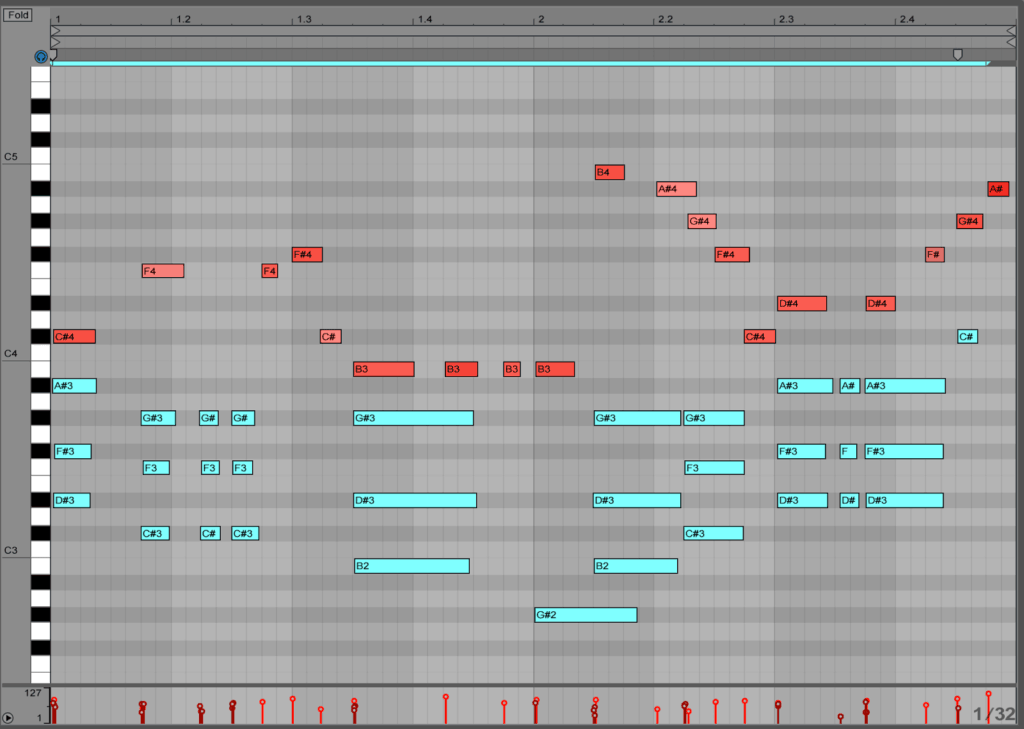
Listen here:
From there, let’s take a look at the chord progression alone.
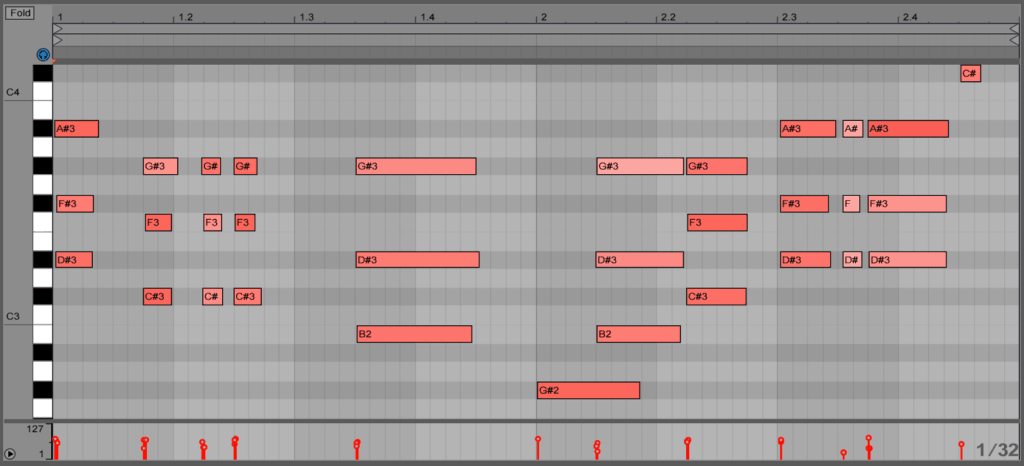
Listen here:
And then, Breaking this down further, this is what the chord progression looks like once we remove the rhythmic movement.
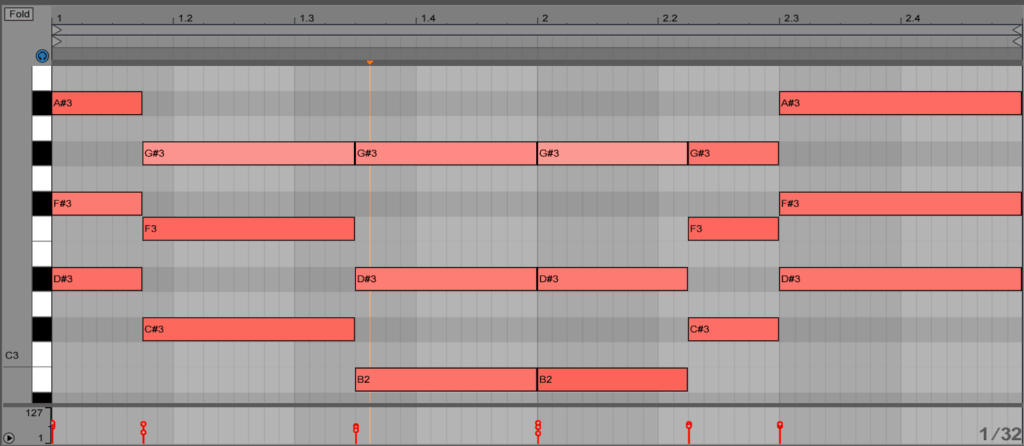
Listen here:
Essentially, this is it for both the verse and the chorus.
Note that this progression is written in the key of Eb Minor.

The chord progression is: Ebm – Db – Abm – Abm – Db – Ebm
Alternatively, in the key of Ebm, the roman numeral notation is i – VII – iv – iv – VII – i.
(For any of you theory snobs, it’s technically i – VII – iv6 – iv6 – VII – i.)
Note that when the bells come in Bar 13 (0:32), the chordal movement is simplified a bit, but the overall melody and chords stay the same.
Similarly, during the chorus the overall chord progression and melody are the same, while the rhythm and length of some of the notes change slightly.
We’ll discuss the importance of this later.
Get 25 high-quality MIDI chord progression files for free 🎹
Our Track Breakdown MIDI Vault is packed with chord progression MIDI files from songs like Mura Masa’s ‘Lovesick’, Flume’s ‘Say It’ & more! 👇
Key Takeaways:
- Simplicity in Action
- Same Melody, Different Presentation
- Simple, but Catchy
- Locking in the Groove
- We’ll Do it Live
- The (Essential) Relationship Between Chords and Melodies.
- Bass vs Chords
- The Power of Melodic Fills
1. Simplicity in Action
First off, what makes this track work is the simplicity of the chords and the simplicity of the arrangement.
The chord progression is 2 bars long, which makes it easy to remember.
There are only 3 chords, further making it easy to remember.
The chord progression is simple, but not basic.
Even though it’s short with just a few chords, the progression is still interesting and memorable.
The way that Mura Masa positions the chords doesn’t make them feel like a static, boring three chord progression.
Let’s a look at the sustained chords by themselves.
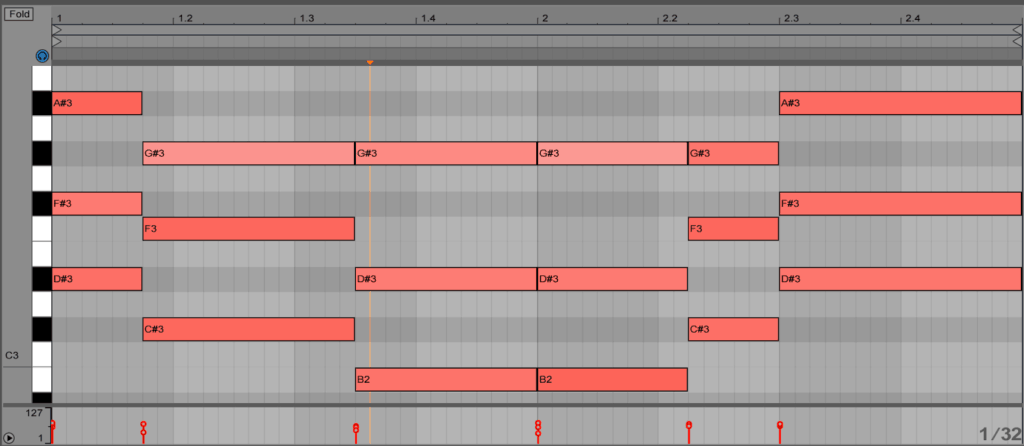
Technically, there are 6 chords in this chord progression. However, there are only three unique chords in this Ebm – Db – Abm – Abm – Db – Ebm progression.
So while the progression feels like it’s constantly moving, it is only cycling between three chords.
Frequent changes make the progression dynamic, while the use of a small number of chords makes the progression seem familiar.
This right here, is Pop Writing 101: The main hook should sound like something you’ve heard before, while still being unique.
Want an example of this? Take the biggest pop song of 2016, “Closer” by the Chainsmokers.
The main hook is eerily similar to that of Fetty Wap’s “679”.
To see the similarities, check out Genius’s comparison video.
If you’re in the business of writing popular music, take note.
Much of writing a good chord progression and melody is finding the middle ground between new and familiar.
Mura Masa does just that with this chord progression. He presents you three chords for both the verse and chorus, but does so in a way that continually keeps your attention.
2. Same Melody, Three Ways
The other way Mura Masa makes this chord progression work is the way he presents it throughout the song.
Let’s visually dissect the main sections of the song.
Below, we’ve broken down the first 5 sections of the track.
The intro is 4 bars, while the next four sections are all 8 bars long.

The breakdown, verse, chorus, and post-chorus all have nearly the same chord progression melody.
Why doesn’t this get boring?
Well, Mura Masa gives you the same melody, but he presents it to you in four different ways.
During the breakdown, the chords and melody are taken up by a piano; during the verse they’re taken up by the bells; in the chorus they’re played by the synth lead; and in the post-chorus both the piano and bells play the main melody and chords.
While the melody and chords are the same, they don’t sound the same, since a different instrument plays them during each section.
Going back to our Pop Writing: 101 discussion earlier, this achieves a similar effect as the progression itself: it sounds familiar, but it isn’t exactly the same.
Because we’re hearing the same chord progression and melody, each section sounds familiar.
However, new instruments help to develop and push the song forward, making the song dynamic and interesting.
What can we take away from this?
We don’t always need to change the chord progression and melody between sections. Slight melodic changes and instrument changes often do the trick.
3. Simple but Catchy
Earlier, we touched upon the idea that this song works because it’s simple: a two bar chord progression and melody, repeated for most of the song.
However, this song doesn’t work just because its main melodic idea is simple.
While short in length, the main melody and chords are really, really good.
The hook is so catchy and groovy that we’re not mad that we hear it for the full song.
The main takeaway? Be simple, but catchy.
Obviously, writing a catchy hook is easier said than done. But, with the right techniques, anyone can do it.
It’s important to analyze music to figure out what makes it work.
Growing as a songwriter is a lengthy, difficult process.
Analyzing great melodies is invaluable to this process.
The more we understand and internalize what makes up a great hook, the better we will become at writing hooks ourselves.
4. Locking in the Groove
Something we haven’t discussed yet is the groove, which is the backbone of this song.
The drum break intro isn’t there just so DJ’s can easily mix it into a set.
It’s there to set the groove and rhythm for a track.
Recently, I saw Mura Masa play a live show in Los Angeles, and he opened his set by playing that drum loop looped for a solid two minutes, during which not a single person in the crowd stopped dancing.
Right away, as a listener, the intro to “Lovesick ***k” tells you that rhythm is critical to this song.
Thus, it makes sense that the chord progression and melody are both rhythmically active.
Let’s take another look at the midi for the chords and melodies.
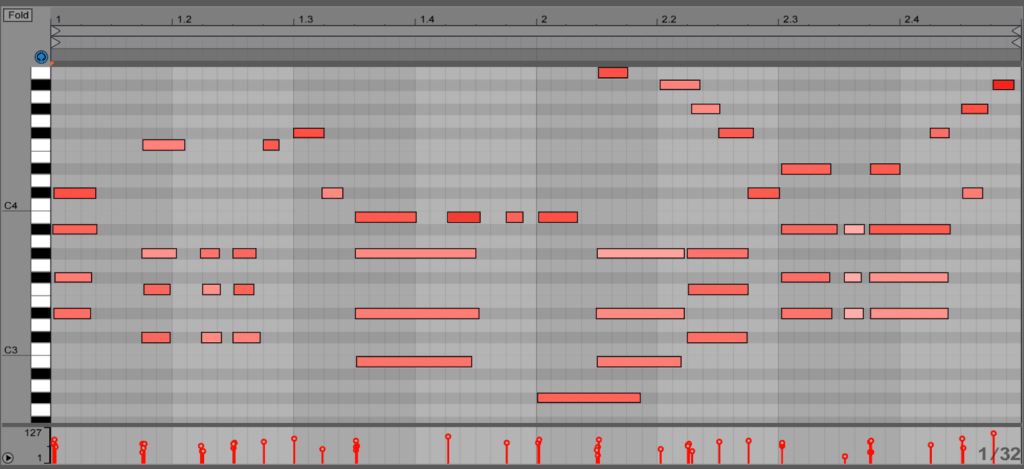
Listen here:
Why is it so important that this hook has a catchy groove?
Because this hook is both melodically catchy and rhythmically interesting, it doesn’t need anything else to push the track forward.
Once Mura Masa starts adding, drums, bass, and synths, he’s adding onto what is already a full and complete hook.
The result?
A track so hot that A$AP begged to be on it.
If you’ve got a bad hook, you can dress it up all you want with tom fills and snare rolls, but in the end you’ve still got a bad hook.
Too often, producers try to make up for a bad melodic foundation by overdoing sound design. Don’t let this be you.
With “Lovesick ***k”, the hook is fantastic, so any sound design that Mura Masa does adds to an already great hook.
Main takeaway: You can polish a turd all you want, but in the end, it’s still a piece of crap. Treat the problem at the source, don’t try to hide the outcome.
5. We’ll Do it Live
Almost certainly Mura Masa played the chords and melody in live.
Part of the aesthetic to Mura Masa’s music is the live feel integrated with an electronic production.
In “Lovesick ***k”, the live aspect is first introduced by the drum break, then further developed by the piano.
The subtleties that make this chord progression work all correlate to the “live” feel of it.
I played in my transcription of the chords and melody myself and, to be honest, it’d be really hard to do otherwise.
(Warning: Tangent Coming)
Regardless of your prefered style of music, I highly recommend you learn to play the piano.
The main reason for this? Genres change, styles change, and trends change.
However, the musical element of music has been pretty consistent for the past couple hundred years or so.
Becoming comfortable at the piano (or your instrument of choice) is an indispensable skill that you’ll be able to use for the rest of your life.
Your knowledge of the double bandpass filter in Serum? Nice to know, but not essential for your tracks.
(Tangent Over)
6. The (Essential) Relationship Between Chords and Melodies
The chords and melody of “Lovesick ***k” don’t just work: they work together, both from a melodic and rhythmic aspect.
When we are writing a melody over a chord, it’s important to understand the relationship between chord tones and non-chord tones.
Simply put, a chord tone is a note that is present within the chord, and a non-chord tone is a note that does not belong in the chord.
For example, let’s say we are in the key of C Major.
The C Major triad is C-E-G.
In this case, an E would be a chord tone, while an F would be a non-chord tone.
Non-chord tones typically add tension that would like to be resolved, while chord tones sound pleasant and nice.
A great progression typically has a balance between the two: a blend between tension and release.
If you want to learn more about chord tones, check out this great lesson on what they are.
Its especially important to pay attention to melody notes that occur at the same time as the chords.
Below, we’ve highlighted when the chords and melody line up in the main progression of “Lovesick *k”.
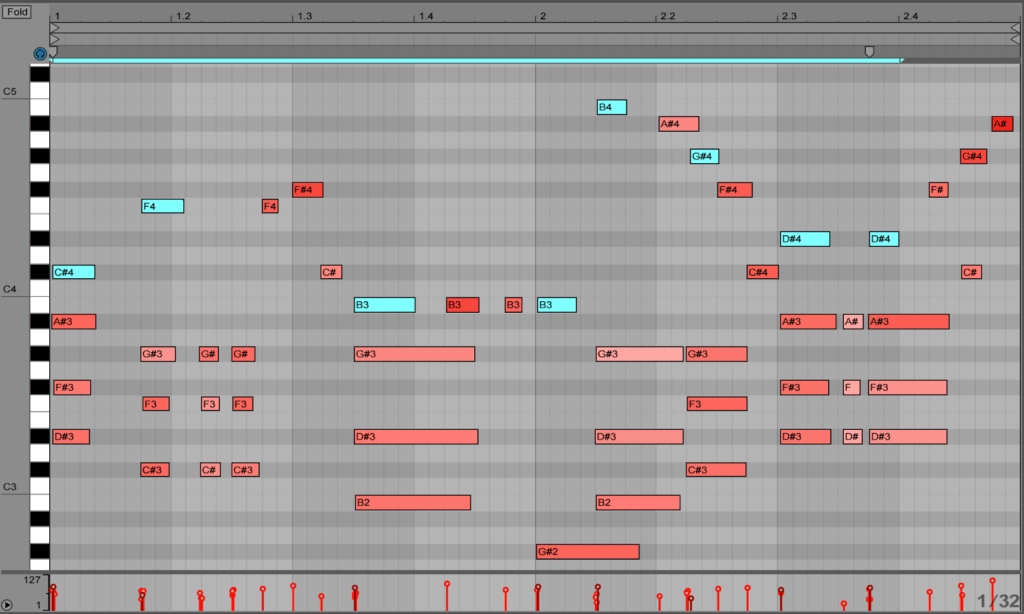
For example, the first melody note, C# (really Db), isn’t in the first chord D#m (really Ebm).
Thus, C# is a non-chord tone, which adds tension to the progression.
Starting off the progression with tension is an interesting choice.
How does Mura Masa pull it off?
All of the other accented melody notes are chord tones.
For the rest of the progression, every time the melody lines up with the chords, its a chord tone.
The melody moves around a lot, but it always lands on a chord tone.
Let’s listen to it again:
The melody is both rhythmically and melodically active, yet it always lines up nicely with the chords.
The way the melody moves in between the chords is dynamic and compelling, while the relationship between the melody and chords beautifully resolves.
Altogether, this makes their relationship harmonically (and emotionally) pleasing.
Main Takeaway: Understand the melodic relationship between melodies and chord progressions.
Find a balance between chord tones and non-chord tones, tension and release.
7. Bass vs. Chords
The bass during the verse typically plays the root note of the chords.
There are also some slight suspensions and anticipations, for those of you who are interested in more advanced music theory.
During the chorus, however, the bass is a bit more interesting.
Here is the bass during the chorus.
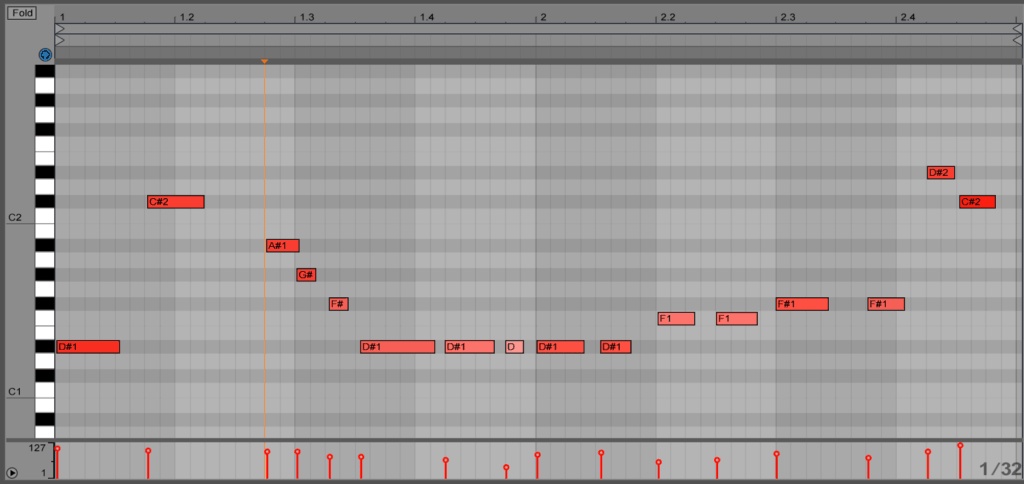
Listen here:
Let’s see how this lines up with the chord progression.
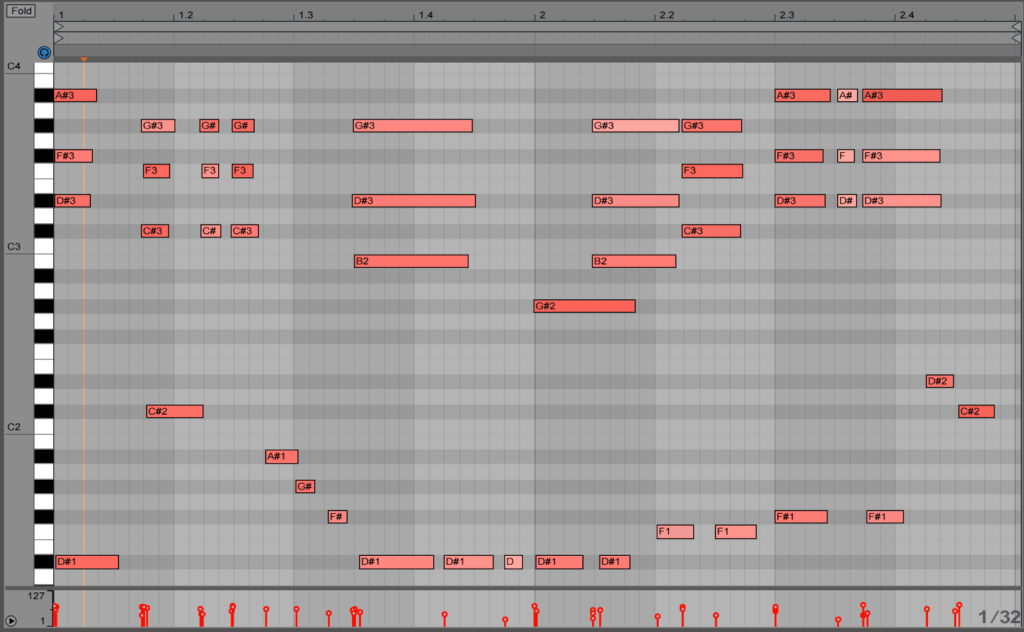
Listen here:
Huh?
Rhythmically it appears as if the bass lines up with the chords, but the bass isn’t always playing the root note of the chords.
Truth is, we don’t have to use the root note of a chord in the bass.
We can use any of the notes in the chord, creating what is called a slash chord.
While the bass isn’t always playing the root note, it’s always playing a note in the chord (i.e. a chord tone).
To help show this, I’ve highlighted the bass note and the corresponding chord tone in each chord.
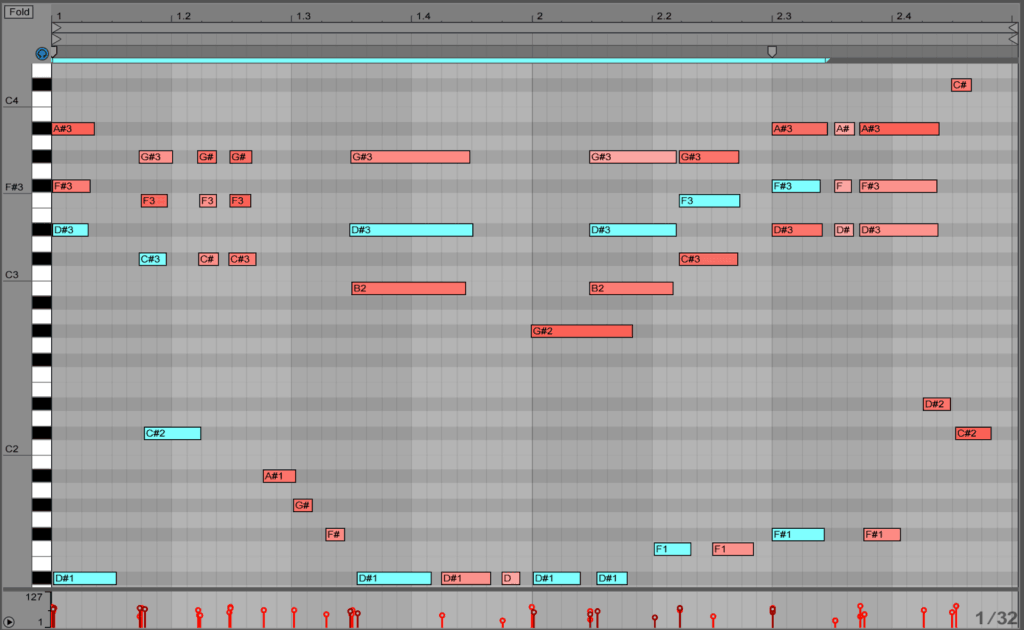
As we can see, the bass isn’t always playing the root note; it often plays another note in the chord.
For example, the third chord is a G#m triad (G# – B – D#) .
Instead of playing a G# in the bass, there is a D#, which is the fifth of the G#m chord.
The result is a more lively, interesting bass line.
A bassline that follows the chords is fine, but it doesn’t add much to make the chords more interesting.
The slash chords and melodic fills Mura Masa uses add another level of depth and development to the track.
One could almost look at the bassline as another melodic hook.
Main Takeaway: Use slash chords to expand your musical vocabulary.
8. The Power of Melodic Fills
Believe it or not, there was a time when musicians transitioned between sections without white noise and snare fills.
I know, right?
Instead, they used melodies and chords to help smooth sectional transitions.
Mura Masa does this effectively between the bridge and the second chorus, at Bar 52 (2:19).
He uses a melodic bass fill, paired with a drum fill, to transition from the bridge into the chorus.
Here is the bass fill played before the second chorus (Bar 1 below is the first bar of the second chorus).
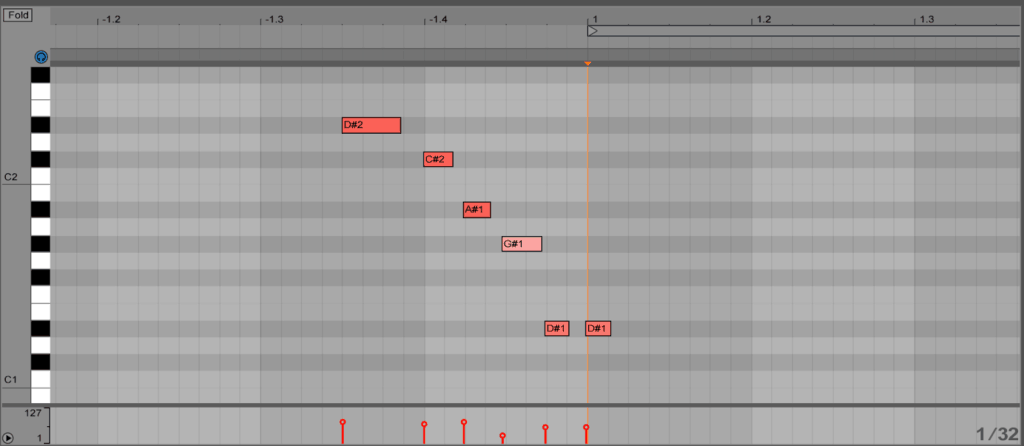
Listen here:
There’s nothing too complex going on here, simply a downward fill that lands on D# (Eb), the first bass note in the chorus.
This simple fill effectively transitions the song from the bridge and the chorus.
It also does this subtly and naturally, as opposed to an overly complex drum fill, which, to be honest, is way overdone among modern producers.
This is in no way a revolutionary technique used by Mura Masa, but it’s commonly overlooked by producers.
Using FX is the easy way out; forcing a listener between sections is no way to arrange a song.
Rather, take the time to carefully craft melodic content to help smooth out the arrangement.
Main Takeaway: When transitioning between sections, consider how your melodies and chords can help the transition.
Try adding melodic fills, using bass rolls, or removing the bass in the last bar to naturally transition between sections.
Want free access to the Track Breakdown MIDI Vault? You can download the MIDI from all of our Track Breakdowns, as well as 25 hi-quality MIDI chord progressions you can use in your own productions.
Get 25 high-quality MIDI chord progression files for free 🎹
Our Track Breakdown MIDI Vault is packed with chord progression MIDI files from songs like Mura Masa’s ‘Lovesick’, Flume’s ‘Say It’ & more! 👇
Summary
We hope you were able to take away some useful tips from this article. Learning how to write and arrange is a difficult process, so we want to help make the journey as easy as possible for you.
We tried to pull out as much valuable information as we could from this song, helping you to better understand what makes a great song, well, great.
There’s a good amount of information to digest here, so we recommend re-reading it a few times to soak up all the different elements.
The point isn’t to memorize everything in this article, but to let this article guide your workflow, and add additional tools to your music-writing arsenal.
We plan on doing more of these track breakthroughs, so we’d love to hear any feedback you may have. And if there are any songs you’d like us to cover, please let us know!
Want to read more breakdowns? Click here to visit the Track Breakdown Glossary.
Disclaimers:
- While Ebm and D#m are enharmonically equivalent scales (i.e. have the same notes). Ebm is more commonly used, but unfortunately Ableton only displays notes as sharps instead of flats. We use them interchangeably, just know they reference the same notes/chords.
- The transcriptions aren’t 100% exact, but they’re essentially there. The point of this article wasn’t to exactly copy the song; rather, we wanted to get the general idea of the melodies and chords, so as to further break them down. If you have a better ear than us, please let us know. However, I think we got pretty close.

